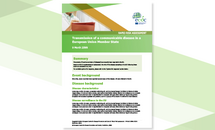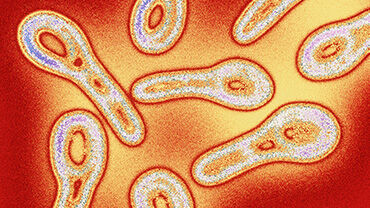Increase of reported diphtheria cases among migrants in Europe due to Corynebacterium diphtheriae, 2022
As of 26 September 2022, 92 cases of diphtheria among migrants have been reported by seven European countries for the year 2022. Sixty-six of these cases presented with cutaneous diphtheria caused by Corynebacterium diphtheriae. Cases of respiratory diphtheria have also been reported, including one fatal case. The cases are among males, and most have been diagnosed in reception centres for migrants. Additionally, one case of cutaneous diphtheria was detected in a staff member at a reception centre in Switzerland. Most of the cases reported by EU/EEA countries and the UK in 2022, were infected by strains of C. diphtheriae for which toxin production was confirmed. For a limited number of cases, mainly in Switzerland, the toxigenicity has not been determined or reported.
Executive summary
Diphtheria is a rare disease in the EU/EEA. An average of 52 cases were annually reported across the EU/EEA to ECDC between 2016 and 2020. Around 50% of reported cases were caused by Corynebacterium (C.) diphtheriae. Of the 128 cases caused by C. diphtheriae reported between 2016-2020, 60 were cutaneous, 25 respiratory, and one had both a cutaneous and respiratory presentation. Forty-two cases had a different clinical manifestation or missed information about the clinical manifestation. During this five-year period, 69 C. diphtheriae cases were classified as imported in eleven EU/EEA countries (an average of 14 imported C. diphtheriae cases per year), and of these, 46 presented with a cutaneous disease. It was not possible to confirm the potential migratory status of these cases as their reason for travel to the EU/EEA was not reported.
The number of cases reported so far in 2022 represents an increase compared to the average number of imported cases seen in recent years. This increase could be explained by an increased volume of migrants from diphtheria-endemic countries, by an increased circulation of the pathogen in the countries of origin, or by an increased risk of transmission in specific settings such as migrant reception centres. As of 26 September 2022, ECDC is not aware of any evidence indicating outbreaks in the broader EU/EEA population resulting from the increased number of imported cases.
An analysis of sequences from the cases reported in migrants in 2022 revealed three different sequence types (ST): ST377, ST384 and ST574. The phylogenetic analysis showed clustering between the isolates within each of the STs reported. The public health relevance of this finding is currently under investigation with the collection of additional epidemiological information from cases. The risk for individuals in the broader community of contracting diphtheria is very low, provided they have completed their diphtheria vaccination schedule. However, the risk is assessed to be moderate for individuals who are unvaccinated or immunosuppressed and live or work in reception centres or other similar crowded settings in the EU/EEA, but low for fully vaccinated individuals in those settings.
The options for response for this event include the following:
- Identification and vaccination of individuals residing in migrant centres who have incomplete vaccination status, are unvaccinated or have unknown vaccination status, through the administration of a booster dose or a complete course of a diphtheria toxoid-containing vaccine, according to national guidelines.
- Provision of information to migrant centres’ health service providers for the rapid identification and isolation of possible cases pending diagnostic confirmation.
- Respiratory droplet isolation of all confirmed or suspected cases with respiratory diphtheria is required. If facilities are not available for droplet isolation, screens should be placed between cases to limit potential transmission.
- Contact precautions, such as avoiding contact with wounds and the dressing of wounds, are required for confirmed and suspected cases of cutaneous diphtheria.
- All confirmed cases, whether presenting with respiratory or cutaneous disease, should remain in isolation until the elimination of the organism is demonstrated by two negative cultures obtained at least 24 hours apart after completion of antimicrobial treatment.
- Identification of close contacts, especially contacts who may have been directly exposed to oral and skin ulceral secretions from the cases. This may include personnel giving assistance to confirmed cases, especially if they performed procedures without appropriate personal protective equipment (PPE). The clinical conditions of contacts should be monitored regularly for 10 days and swabbing (nose and throat) of close contacts should be performed regardless of their immunisation status.
- Antimicrobial post-exposure prophylaxis and vaccination of incompletely vaccinated or unvaccinated close contacts after nasopharyngeal and throat swabs have been collected, regardless of culture result and according to national or regional recommendations. Further clinical management of confirmed cases, including the use of DAT, should be undertaken according to national guidelines.
- Alerting clinicians to the possibility of cutaneous and/or respiratory diphtheria among migrants and travellers returning from endemic areas, and provision of testing algorithms and instructions on how to take samples and how to transport samples to the laboratory. For countries where toxigenicity needs to be assessed in the WHO Reference Laboratory, timely transportation is crucial to ensure early diagnosis.
- Collection of data on the country of origin and migratory route from all suspected diphtheria cases, with collection of detailed information on their stays in migrant camps or overcrowded accommodations where diphtheria transmission may have occurred in order to identify settings where transmission of diphtheria may have occurred.
- Ensure that the vaccination status for all personnel working in reception centres for migrants is up-to-date, according to their national vaccination calendars.
- Limiting situations of overcrowding in migrant centres.
- Verification of the availability of laboratory diagnostics in each country, as timely laboratory confirmation of cases is vital for implementing control measures.
- Timely reporting to competent national and international authorities of cases confirmed according to the EU case definition.
- Enhanced surveillance, including molecular typing and whole genome sequencing of patient isolates to improve the understanding and monitoring of transmission patterns. The timely collection and sharing of sequencing data combined with epidemiological information can support generating hypotheses on where transmission has occurred. ECDC can offer WGS support for Member States seeking assistance. For further information and instructions regarding this support, contact typing@ecdc.europa.eu.








